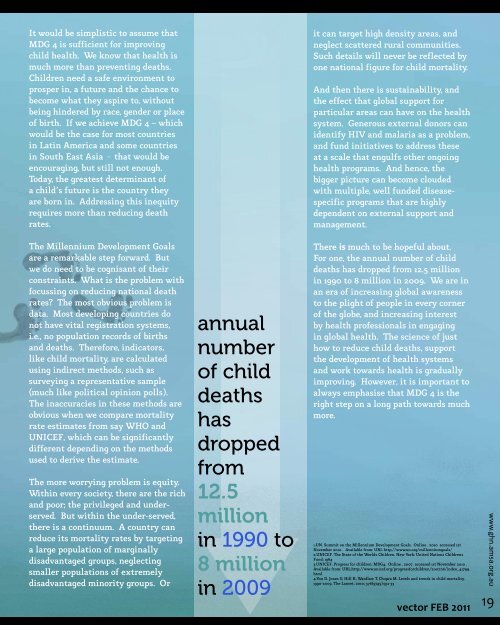You also want an ePaper? Increase the reach of your titles
YUMPU automatically turns print PDFs into web optimized ePapers that Google loves.
It would be simplistic to assume that<br />
MDG 4 is sufficient for improving<br />
child health. We know that health is<br />
much more than preventing deaths.<br />
Children need a safe environment to<br />
prosper in, a future and the chance to<br />
become what they aspire to, without<br />
being hindered by race, gender or place<br />
of birth. If we achieve MDG 4 – which<br />
would be the case for most countries<br />
in Latin America and some countries<br />
in South East Asia – that would be<br />
encouraging, but still not enough.<br />
Today, the greatest determinant of<br />
a child’s future is the country they<br />
are born in. Addressing this inequity<br />
requires more than reducing death<br />
rates.<br />
it can target high density areas, and<br />
neglect scattered rural communities.<br />
Such details will never be reflected by<br />
one national figure for child mortality.<br />
And then there is sustainability, and<br />
the effect that global support for<br />
particular areas can have on the health<br />
system. Generous external donors can<br />
identify HIV and malaria as a problem,<br />
and fund initiatives to address these<br />
at a scale that engulfs other ongoing<br />
health programs. And hence, the<br />
bigger picture can become clouded<br />
with multiple, well funded diseasespecific<br />
programs that are highly<br />
dependent on external support and<br />
management.<br />
The Millennium Development Goals<br />
are a remarkable step forward. But<br />
we do need to be cognisant of their<br />
constraints. What is the problem with<br />
focussing on reducing national death<br />
rates? The most obvious problem is<br />
data. Most developing countries do<br />
not have vital registration systems,<br />
i.e., no population records of births<br />
and deaths. Therefore, indicators,<br />
like child mortality, are calculated<br />
using indirect methods, such as<br />
surveying a representative sample<br />
(much like political opinion polls).<br />
The inaccuracies in these methods are<br />
obvious when we compare mortality<br />
rate estimates from say WHO and<br />
UNICEF, which can be significantly<br />
different depending on the methods<br />
used to derive the estimate.<br />
The more worrying problem is equity.<br />
Within every society, there are the rich<br />
and poor; the privileged and underserved.<br />
But within the under-served,<br />
there is a continuum. A country can<br />
reduce its mortality rates by targeting<br />
a large population of marginally<br />
disadvantaged groups, neglecting<br />
smaller populations of extremely<br />
disadvantaged minority groups. Or<br />
annual<br />
number<br />
of child<br />
deaths<br />
has<br />
dropped<br />
from<br />
<strong>12</strong>.5<br />
million<br />
in 1990 to<br />
8 million<br />
in 2009<br />
There is much to be hopeful about.<br />
For one, the annual number of child<br />
deaths has dropped from <strong>12</strong>.5 million<br />
in 1990 to 8 million in 2009. We are in<br />
an era of increasing global awareness<br />
to the plight of people in every corner<br />
of the globe, and increasing interest<br />
by health professionals in engaging<br />
in global health. The science of just<br />
how to reduce child deaths, support<br />
the development of health systems<br />
and work towards health is gradually<br />
improving. However, it is important to<br />
always emphasise that MDG 4 is the<br />
right step on a long path towards much<br />
more.<br />
1.UN. Summit on the Millennium Development Goals. [Online]. 2010 [accessed 1st<br />
November 2010]. Available from: URL http://www.un.org/millenniumgoals/<br />
2.UNICEF. The State of the World’s Children. New York: United Nations Children’s<br />
Fund; 1984<br />
3.UNICEF. Progress for children: MDG4. [Online]. 2007 [accessed 1st November 2010].<br />
Available from: URL:http://www.unicef.org/progressforchildren/2007n6/index_41799.<br />
html<br />
4.You D, Jones G, Hill K, Wardlaw T, Chopra M. Levels and trends in child mortality,<br />
1990-2009. The Lancet. 2010; 376(9745):931-33<br />
www.ghn.amsa.org.au<br />
vector FEB <strong>2011</strong><br />
19

















